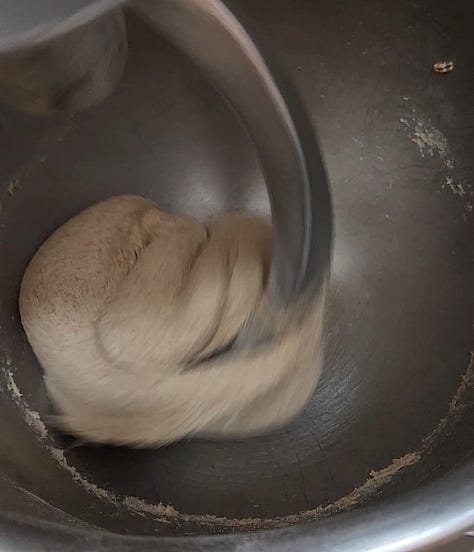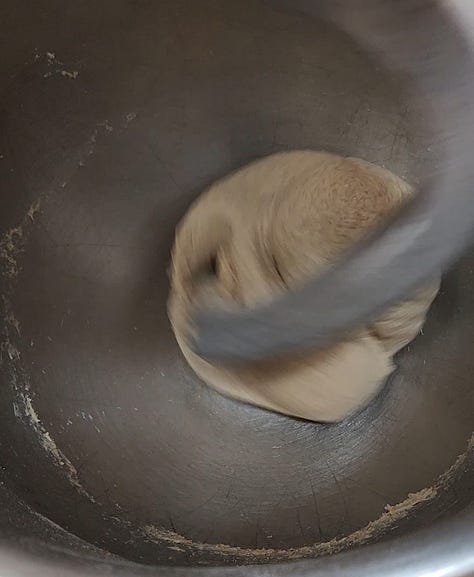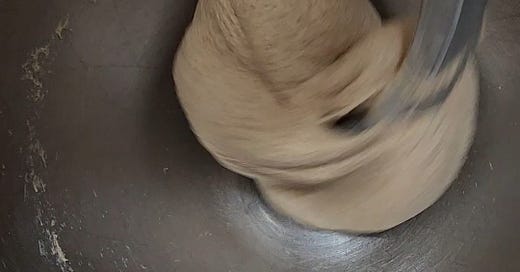First, What is Gluten?
Gluten is simply the name for the protein in wheat and many other grains.
The Basics of Gluten
Gluten is a blanket term; it does not mean just one thing.
First, from a scientific perspective, gluten actually refers to two proteins that work in tandem: glutenin and gliadin. Glutenin is responsible for pulling back or squeezing in. Gliadin is responsible for elasticity. These two components are not always present in equal amounts or equally effective. That’s why simply knowing the protein content of a grain or flour will not give you the full picture. The best way to understand how the gluten of any particular flour will function is to do test bakes and use your senses every step of the way.
Second, from a genetic perspective, gluten from different grains will simply have a different genetic code. That’s why some people who are sensitive to gluten can eat certain grains that contain it, but not others. It’s also why breads made with a high percentage of grains like rye or spelt may have a high gluten content on paper, but don’t have the capacity to produce light, fluffy loaves.
Gluten is activated, or woken up and encouraged into networks, simply by getting flour wet and moving it around, whether that be by stirring, kneading, mixing, or any other motion.
Gluten’s Role in Pastry
We’re getting this one over with first because it’s the simplest one. Basically, the goal in most pastry is to keep gluten from really playing a role at all. Most of the textures we desire, such as tenderness in cakes and crispness in shortbread, are the antithesis of what activated gluten offers. So, in pastry baking, we take steps to make sure the gluten content is simply never activated.
In many recipes, the flour and other dry ingredients are added last, enabling us to work the flour, and therefore develop the gluten, as little as possible. In other recipes, such as those that utilize the reverse creaming method, flour and fat are mixed together early on, and the fat blocks the gluten from absorbing liquid, therefore making activation difficult.
Croissants and other laminated items are an exception to this. Gluten development is essential in creating a network that can hold as much butter as possible. That’s one reason why laminated doughs should really be considered their own category, separate from pastry or bread.



Gluten’s Role in Bread
Gluten plays an essential role in bread. Bread is significantly more difficult than pastry, especially when using full-inclusion flour, because it’s so simple. Really, only four ingredients are supposed to make any particular loaf of bread successful: flour, water, salt, and yeast. Some people like to add time to this list, and while time is not an ingredient per se, it is a very important component to developing a successful loaf.
Each of these four base components interacts with the others and has complex functions. However, at the most basic level, the yeast breaks down the starches in the flour into sugars, eats them, and produces carbon dioxide. The carbon dioxide, with the help of the heat applied to it during baking, is solely responsible for the entire lift of the loaf. What keeps the carbon dioxide in place? The gluten structure.
When gluten is activated by contact with water and kneading (or extended mixing, in a commercial setting), it forms bonds that create an intricate network capable of trapping the carbon dioxide. Without a properly developed network, all the carbon dioxide is lost, and the resulting loaf will be flat and dense.
Gluten Beyond Flour, Water, Salt, and Yeast
Of course, bread can include many other additions, such as oats, seeds, or even nuts and dried fruits. But these are all there to enhance the flavor and texture, not to contribute to the basic structure or function of a loaf.
There are also commercial additives that some bakers use, such as dough relaxers. These additives are intended to compensate for so-called deficiencies in dough, such as less-than-ideal gluten function. Many of these deficiencies, dare I say, could be negated by the correct application of an experienced baker’s skill, rather than a chemical cop-out. More on that in this week’s recipe.
The only additive we do use from time to time and fully endorse (when sourced from a reputable, clean company) is diastatic malt powder. Diastatic malt powder is made from sprouted barley, and it’s essentially yeast food. In doughs with an extra long fermentation, the yeast cells consume too much of the starch, meaning that there isn’t enough sugar left for the Maillard Reaction to produce a lovely dark brown crust. Adding a very small amount of diastatic malt powder (usually about half the weight of the yeast) helps prevent this problem.
How to Maximize Gluten Function in Full-Inclusion Pastry and Bread
There are two key differences in using full-inclusion flour that impact gluten function. The first is enzyme activity. Many different enzymes live on the exterior part of a grain berry, the bran. In white flour, the rising agents you add, such as baking powder or baking soda in pastry or yeast in bread, have free reign over all the nutrients and create pretty much all of the activity that occurs in your raw batter or dough. This is not so in full-inclusion baking! The enzymes are alive and well, competing for nutrients and causing a bit of chaos.
In pastry, because the batter hits the oven relatively quickly, the enzymes don’t have much time to interfere. Even in things like cookie doughs that may sit in the refrigerator for up to a week, you’re not relying on gluten structure or even a very particular acidity level for your basic function, so the enzymes really aren’t an issue.
However, in bread, increased enzyme activity can have a dramatic effect. The enzymes will effectively ferment the dough in their own way, meaning the dough proofs more quickly and is more volatile. If left unchecked, the enzymatic activity can lead to too much sourness, and if we’re looking for a light, airy loaf, we want the yeast cells to thrive, not compete.
The second key difference with full-inclusion flour is the bran content itself. In pastry, bran content has little effect; it mostly just adds a bit more texture. However, when bread dough is mixed, the gluten strands activate. But in doughs with a high bran content, the sharp bran particles act as blades that cut the gluten strands as soon as they develop. This makes mixing and working with full-inclusion flours more difficult.
This week’s recipe is a deep dive into various starters. We’ll also discuss some tips and tricks for overcoming enzyme and bran issues in full-inclusion bread doughs. This will be the first step in our eventual journey into full-inclusion bread baking. Next week, we’ll continue on the topic of gluten, and don’t fear, we’ll get back to into pastry recipes for a little while. Let’s get baking!




Wow! Who knew gluten was so complicated. Thanks for making it clearer.